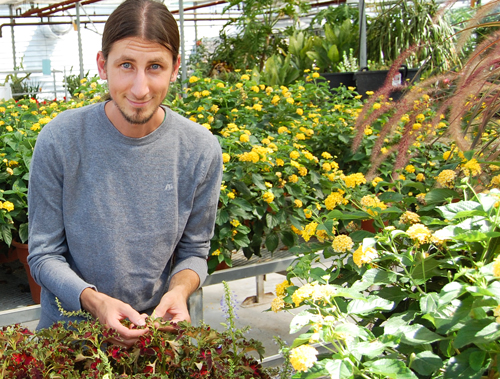Story by Natalie Osborne, a member of the SPARK program (Students Promoting Awareness of Research Knowledge)

Ontario has one of the largest greenhouse sectors in the world, producing flowers, fruits and vegetables that are sold across Canada and internationally. Ontario growers know that if agricultural pests accompany their products, they’ll be refused at foreign borders. Invasive “quarantine” pests are known to interfere with production and even compromise human health.
That’s why Guelph researchers are using DNA barcoding technology to identify and track harmful greenhouse pests. Barcoding uses short standardized gene sequences to classify and catalogue species in the Barcode of Life Data System (BOLD).
This research involves Prof. Robert Hanner, associate director for the Canadian Barcode of Life Network, and Prof. Cynthia Scott-Dupree, School of Environmental Science, as well as PhD student Andrew Frewin.
They are genetically profiling expert-identified specimens of various pest species to build a barcode reference library of greenhouse pests and the parasites that prey on them. Once complete, it can be used as a surveillance tool to identify invasive and harmful insects.
Many Ontario greenhouses bring in plant segments, or “cuttings,” from international sources to propagate and distribute across Canada. Without rapid and accurate screening methods, producers could unknowingly bring in quarantine pests along with the cuttings.
“Our greenhouse sector has grown so large and diversified that greenhouse complexes can act as ‘island habitats,’ where exotic and quarantine pests can establish and potentially travel between different commodities,” says Hanner.
With his co-advisers, Frewin has developed a method of barcoding insect remains recovered from cuttings. When it comes to emergency pest management, knowing where and when a specimen was found is just as important as determining what it is.
Guelph researchers have also taken the next step by designing a smartphone application called DNA Barcoding Assistant. This app gives scientists vital information about a specimen before it reaches the lab.
Greenhouse pest managers collect unknown insect samples in special vials, each labelled with a unique QR code. They scan this code into the app, which automatically captures the date, time and location where the specimen was collected and allows them to take a photo of it. This information is then linked to the records in BOLD.
The app provides crucial information about the collected specimen, so that epidemiologists can pinpoint and track a potential pest invasion, helping to predict where and how it may spread.
“With BOLD we can provide OMAF [Ontario Ministry of Agriculture and Food] with a secure online database containing the identity and location of pest and quarantine species,” says Hanner. “This information can be archived and monitored to prevent potential outbreaks.”
Currently, greenhouse pest managers rely on visual clues to identify pests, but recognizing them throughout the various stages of their life cycle is challenging. Pest managers often have no way to distinguish the beneficial insects from the potentially harmful and may spray pesticides as a precaution.
Unnecessary pesticide use can cost producers money, contribute to pesticide resistance and increase the risk of exposing consumers to unwanted chemicals.
“One of the things that make DNA barcoding so powerful is its ability to identify pests in any life stage,” says Hanner. “Since there’s DNA in every cell of every organism, we can easily identify eggs, larvae or even fragmentary remains.”
Barcoding can also confirm the identity and efficacy of biocontrol agents – beneficial insects that naturally prey on greenhouse pests. This can be achieved by barcoding the insects’ stomach contents to make sure they’re eating the pests.
The ability to reconstruct food webs in greenhouses helps researchers understand the pests’ invasion dynamics and is one more way barcoding technology can improve productivity in Ontario’s greenhouse industry.
Graeme Murphy, an OMAF greenhouse floriculture integrated pest-management specialist, is collaborating on this research. Funding is provided by the OMAF-U of G Partnership and Flowers Canada Ontario.